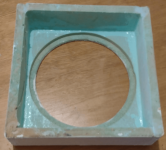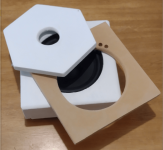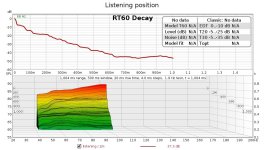My answer showed that questions should be asked correctly, and not as it comes into somebody's head. Otherwise, it looks like disrespect for the respondent, do you agree?Your answer just showed either misunderstanding, disrespect or lack of knowhow.
I don't have a precise answer to your guess, since I haven't done any such evaluation measurements. But in general, I agree that the subsonic filter will significantly move the overload limit towards higher power, however, as for any other type of subwoofer.I assume it will take less than 10W (resp. ~9V@8R) to push the driver into its excursion limit.
A steep subsonic filter might be advised.
Hi DavidScreenprint attached.
(The design was modelled as shown simply so that the impedance, pressure and velocity results given in Post #51 could be readily found).
Just found out you are the creator of Hornresp
Can you share how to set up the simulation of PPD?
And where can I find more detailed instructions for Hornresp?
I'm a novice just getting started
Thank you very much for your sharing and help~
Can you share how to set up the simulation of PPD?
See earlier posts in this thread - two different methods have been suggested.
And where can I find more detailed instructions for Hornresp?
The manual provided in the post linked below may help:
https://www.diyaudio.com/community/threads/hornresp-manual.383370/#post-6949474
See earlier posts in this thread - two different methods have been suggested.
I'll take the time to study the manual and test it outThe manual provided in the post linked below may help:
Thank you very much for your reply and help
Well, since no one answers, I will write my opinion as the author of the concept.Can anyone who has made PPD share the actual listening experience?
Of course, PPD is close in sound to an OB with all the inherent properties, plus a deep bottom and minus efficiency, which must be at least tentatively estimated according to your requirements and wishes.
I don't have experience with OB speakers.
For me it's close to the sound of a Ripol.
For me it's close to the sound of a Ripol.
Thanks for sharing this interesting design! Before I find the saw, would these drivers be suitable? https://www.sbaudience.com/index.php/products/subwoofers/rosso-21sw800/. I already have them, and use them in nearfield no baffle clamshell. If the mms is too large, perhaps these would be a better alternative (16ohm version) https://faitalpro.com/en/products/LF_Loudspeakers/product_details/index.php?id=151070105
Both of them will fit in this design, but the second one of course has ideal parameters for an excellent PPD subwoofer!Before I find the saw, would these drivers be suitable?
Friends a questionI don't have experience with OB speakers.
For me it's close to the sound of a Ripol.
1) Does the PPD give more pressure or same as RiPol
2) A Sealed 70 itre box with 1 nos Beyma 12BR70 be more pressure than one or 2 nos PPD with beyma
Last edited:
The same as RiPol with single driverDoes the PPD give more presure or same as RiPol
This wold be also my assumption. Although I have not compared them directly.
Hello I am new here and just found this interesting thread. Would it be a benefit to couple 2 cabinets together magnets opposite each other, or front opposite each other or a fron and magnet with a ex 1/2 SD as the distance…..?Hi all! I was asked to create this topic as one of the authors of the acoustic design of subwoofers, which was called PPD (Petrenko Petrushevsky's Dipole). In fact, this design, in our opinion, is an improved version of the traditional ripole by Axel Ridtahler. Its main advantage compared to the Axel rippole is the absence of significant unevenness in the frequency response in the region of 150-300 Hz. Additional benefits are lower overall distortion in the subwoofer's operating range and smaller dimensions. With the right choice of TSP speaker parameters, very good results can be obtained, since the smooth frequency response allows the use of second-order filters.
In this video, an example of using a PPD subwoofer on a 15-inch speaker in triphonics.
Would it be better to use a dual voice coil subwoofer on the PPD?The same as RiPol with single driver
I found the following woofer from SB acoustics. What do you think? It should be very suitable - low FS, high linear excursion, high QTS, lightweight membrane.
You could use three of the 16 ohm variant connected in parallel and thus compensate for the low efficiency without having to use a housing that is too tall
You could use three of the 16 ohm variant connected in parallel and thus compensate for the low efficiency without having to use a housing that is too tall
Attachments
Last edited:
Yes, it is very suitableWhat do you think? It should be very suitable
I have 4 6-1/2 speakers and I'd like to test them. I did a Ripole prototype with cardboard and I found it interesting that I liked it. So now I'll move to wood. This is for music.
I know the best way to simulate this is in Hornresp but I have to learn it. I'm using a 6th order band-pass simulation to get the max power for x-max and vent speed. I know this doesn't measure room response but I'll just copy the general shape, make it heavy and see what happens. I'll share the measurements.
I find it interesting that the front port can be just ⌀3cm (15m/s front port air velocity) or ⌀3.5cm (11m/s front port air velocity) according to this simulation.
Remember I know this doesn't measure room response... But I'm wondering how to interpret how the phase changes when I change port sizes, should optimize for a given phase for a target frequency? The data on top is what I measured for this driver and I'm attaching the measurements.

I've also considered making one with a shared rear box but I don't see what the win will be other than less work when assembling it.

I know the best way to simulate this is in Hornresp but I have to learn it. I'm using a 6th order band-pass simulation to get the max power for x-max and vent speed. I know this doesn't measure room response but I'll just copy the general shape, make it heavy and see what happens. I'll share the measurements.
I find it interesting that the front port can be just ⌀3cm (15m/s front port air velocity) or ⌀3.5cm (11m/s front port air velocity) according to this simulation.
Remember I know this doesn't measure room response... But I'm wondering how to interpret how the phase changes when I change port sizes, should optimize for a given phase for a target frequency? The data on top is what I measured for this driver and I'm attaching the measurements.
I've also considered making one with a shared rear box but I don't see what the win will be other than less work when assembling it.
Attachments
Changing port sizes and chamber volumes changes frequency response, the frequency response changes are reflected in the phase response.
I have 4 6-1/2 speakers and I'd like to test them. I did a Ripole prototype with cardboard and I found it interesting that I liked it. So now I'll move to wood.
Hi there. I built them. I need to build the other two.

The measurements are from the two baffles. I could get better measurements later if needed.
Red is from listening position, about 2m from them, 0 deg. Blue is from the back and it has more SPL, the mic was about 1m closer and also closer to the wall. I didn't want to move them for this quick measurement. Green is at 90 deg, 2m.
I don't listen loud, I'll see what I can get when I put the low pass. But I guess I'll build the other two and at some point move to bigger drivers.
Attachments
- Home
- Loudspeakers
- Subwoofers
- PPD subwoofer


